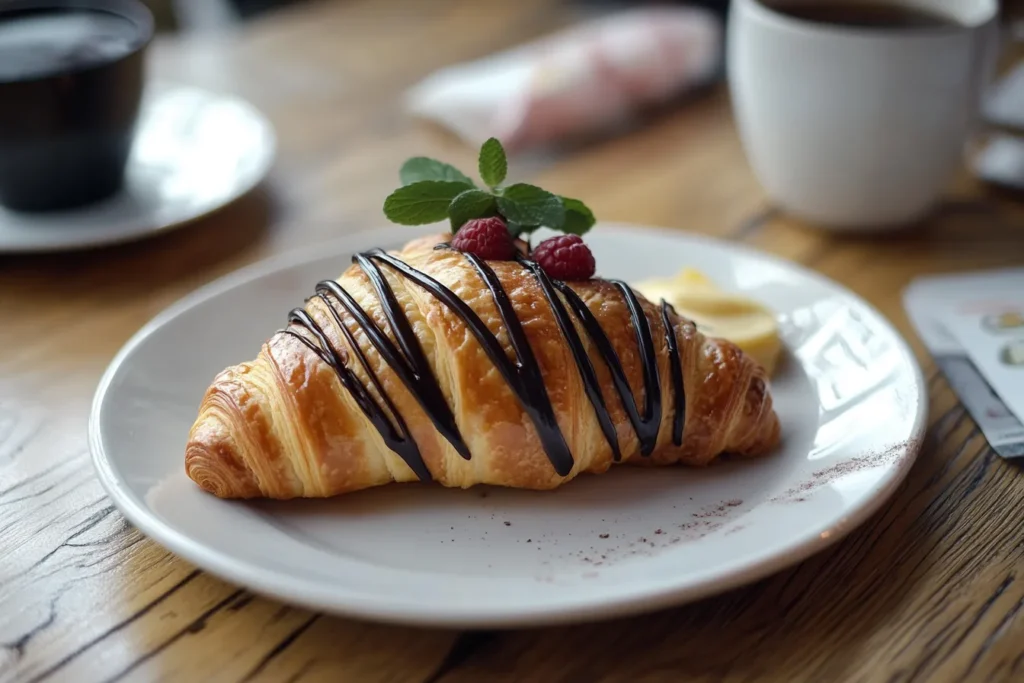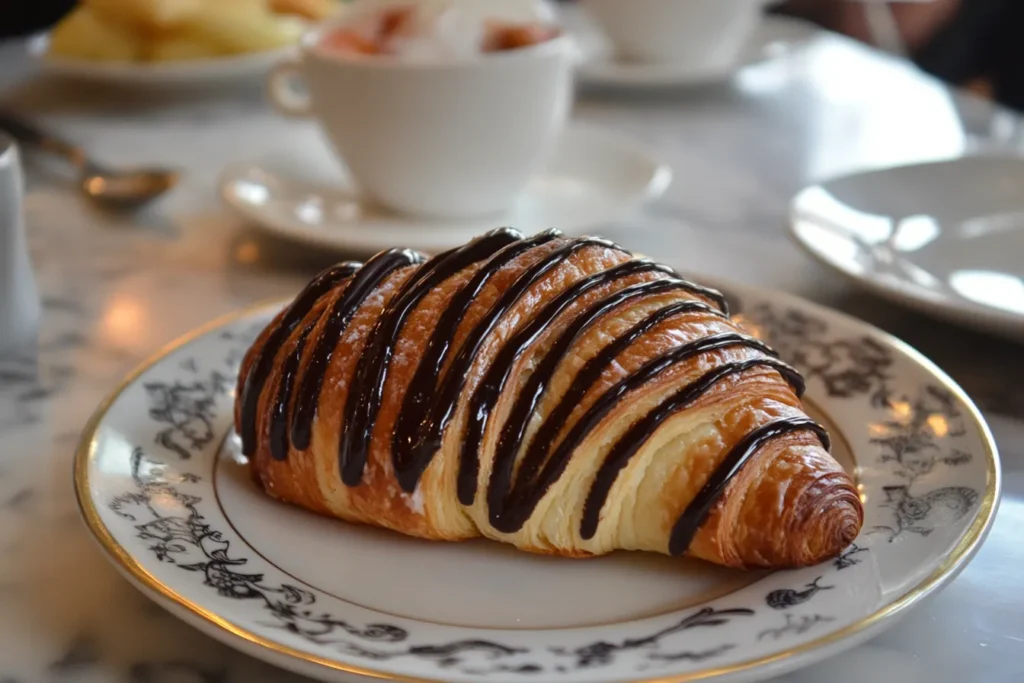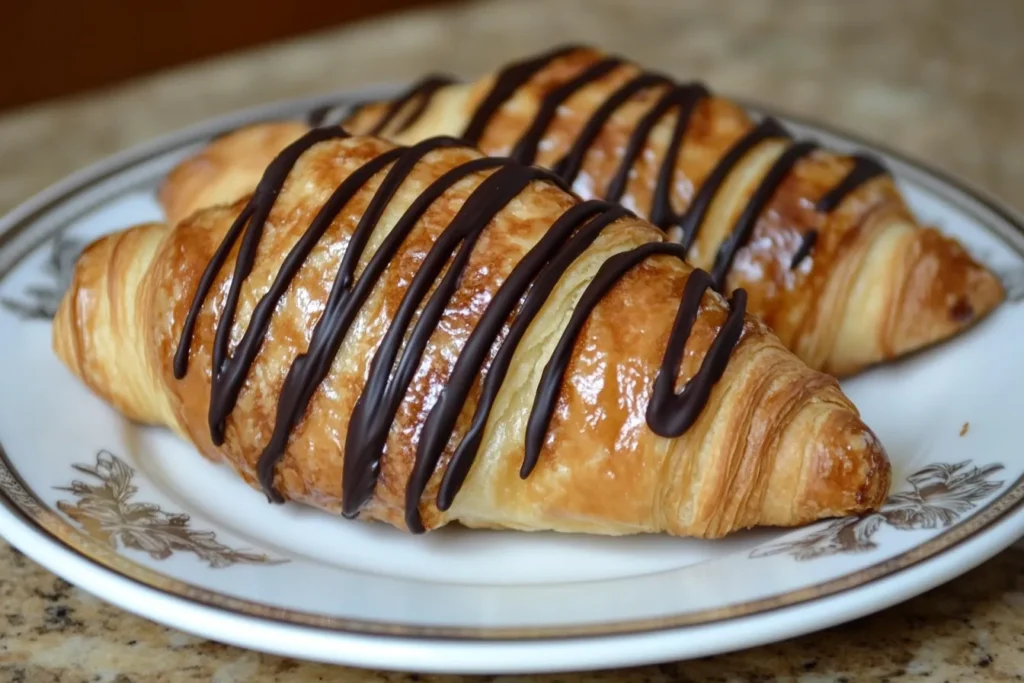Have you ever bitten into a croissant and wondered how something can be so perfectly flaky, buttery, and melt-in-your-mouth soft all at once? It’s almost magical, isn’t it? But if you’ve ever tried to make croissants at home, you’ve probably realized they’re not as simple as they seem. The secret to the croissant lies in its delicate layers of dough and butter, created through a process called laminating. It’s this technique that gives croissants their iconic texture and taste. If you’ve ever felt intimidated by the thought of making croissants or just curious about what makes them so special, don’t worry—you’re not alone. Let’s uncover the secrets behind this French pastry masterpiece and what makes it truly unforgettable!
List Of Contents
The Allure of the Croissant
The croissant stands as a testament to the artistry of baking, combining simplicity and sophistication in every flaky bite. Renowned for its delicate layers and buttery richness, this crescent-shaped pastry has captivated food lovers across the globe. Whether enjoyed at a quaint Parisian café or as a luxurious breakfast staple, the croissant’s universal appeal transcends borders.
But what makes the croissant so iconic? Its allure lies in the contrast of textures: the crisp exterior that gives way to a tender, airy interior. Moreover, its versatility—ranging from sweet almond fillings to savory cheese variations—ensures it remains a timeless favorite. Check out more recipes here.
Origins of the Croissant
The croissant’s origins are steeped in mystery and legend. Although commonly associated with France, its roots trace back to Austria, where the “kipferl,” a crescent-shaped bread, was enjoyed as early as the 13th century. The modern croissant, however, owes much to Viennese bakers who introduced laminated dough to Paris in the late 1700s.
One popular legend ties the croissant to the defeat of the Ottoman Empire during the Siege of Vienna in 1683. Supposedly, the pastry’s crescent shape was inspired by the symbol on the Ottoman flag, serving as a celebration of victory. While this tale adds romantic intrigue, the true evolution of the croissant is likely more culinary than political.
Key Ingredients of a Croissant

At its core, a croissant is a simple combination of flour, butter, yeast, sugar, and salt. Yet, the quality of these ingredients plays a crucial role in achieving perfection:
- Flour: High-protein flour provides the strength needed for the dough’s elasticity and layering.
- Butter: The star of the show, butter lends richness and flavor while ensuring the iconic flakiness.
- Yeast: Responsible for the pastry’s lightness and rise.
- Sugar and Salt: These ingredients balance the flavor profile, enhancing both sweetness and depth.
The magic of a croissant lies in transforming these humble ingredients into a culinary masterpiece through precise technique. Check out more recipes here.
The Role of Lamination
Lamination is the defining process that separates croissants from ordinary bread. By folding and rolling dough with layers of butter, bakers create the distinct flaky structure that croissants are famous for. This meticulous technique involves multiple folds, known as “turns,” which can yield up to 729 layers in a single croissant!
Temperature is critical during lamination. Butter must remain firm but pliable to prevent melting into the dough, ensuring the layers remain intact. Mastering this art requires skill and patience, but the reward is unparalleled texture and flavor.
French Influence on the Croissant
Although Austria birthed the kipferl, France is where the croissant truly flourished. French bakers refined the recipe, introducing laminated dough to create the buttery layers we know today. By the 19th century, the croissant had become a beloved feature of Parisian breakfast culture.
French pâtisseries elevated the croissant to an art form, emphasizing precision and aesthetics. Today, the croissant symbolizes French gastronomy, evoking images of leisurely mornings with café au lait and a pastry in hand. Check out more recipes here.
Croissant Variants Across the World
The croissant’s adaptability has inspired countless variations worldwide:
- Pain au Chocolat: A rectangular croissant filled with rich chocolate.
- Almond Croissant: Topped with almond paste and sliced almonds for a decadent treat.
- Savory Croissants: Stuffed with cheese, ham, or even spinach for a hearty option.
In some countries, croissants take on local flavors, such as matcha in Japan or dulce de leche in Latin America. These innovations highlight the pastry’s global appeal while celebrating regional tastes.
Cultural Significance of the Croissant
The croissant transcends its role as a mere food item, standing as a true cultural symbol. In France, it’s a staple of the continental breakfast, often paired with jam or butter. Yet, its significance extends beyond daily meals. The croissant has become a symbol of indulgence and refinement, appearing in luxury brunch menus and fine-dining establishments.
Moreover, its presence in literature, films, and social media underscores its role as a lifestyle statement. Whether photographed on Instagram or featured in iconic films, the croissant represents an appreciation for quality and elegance.
The Science Behind Flakiness
Flakiness is the hallmark of a perfect croissant, achieved through a combination of chemistry and craftsmanship. When the laminated dough is baked, steam from the butter creates pockets of air, causing the layers to puff up. The result is a pastry that’s light and airy on the inside, yet crisp and golden on the outside.
Temperature control is paramount throughout the process. Dough that’s too warm can result in greasy, dense layers, while dough that’s too cold may not rise properly. Understanding the science behind each step ensures consistent results. Check out more recipes here.
Modern Innovations in Croissant Making
In recent years, bakers have pushed the boundaries of croissant-making with bold flavors and artistic shapes:
- Fusion Flavors: Think matcha, black sesame, or chili-infused croissants.
- Hybrid Pastries: The “cronut,” a croissant-doughnut hybrid, has gained global fame.
- Creative Shapes: From spirals to stars, modern croissants are as much about visual appeal as taste.
These innovations reflect the evolving tastes of consumers, proving that the croissant continues to be a canvas for culinary creativity. Check out more recipes here.
Challenges in Croissant Baking

Croissant baking is not without its challenges. Common pitfalls include:
- Overproofing: Leads to deflated, overly dense pastries.
- Butter Leakage: Results in greasy layers and loss of flakiness.
- Improper Lamination: Yields uneven or lackluster layers.
To avoid these issues, bakers must maintain precision at every stage. Investing in high-quality ingredients, mastering techniques, and understanding the nuances of temperature and timing are key to success.
Understanding Dough Preparation
The foundation of a great croissant lies in preparing the dough with care and precision. Croissant dough is an enriched dough, meaning it includes ingredients like butter, sugar, and milk, which add tenderness and flavor. However, unlike sweet doughs, it must also be strong enough to withstand the lamination process.
Key steps in dough preparation include:
- Mixing the dough just enough to develop gluten, which provides elasticity and strength.
- Allowing the dough to rest, giving the gluten time to relax and making it easier to roll and shape later.
- Maintaining a cool temperature throughout to ensure the butter remains solid during lamination.
Proper dough preparation sets the stage for flaky, well-structured croissants.
Secrets of the Butter Block
Butter is the heart of a croissant, and its consistency can make or break the pastry. The butter block, or beurrage, must match the dough’s consistency to create smooth, even layers during lamination.
Secrets to achieving the perfect butter block:
- Use high-fat European-style butter, which has a lower water content and a creamier texture.
- Chill the butter to keep it firm but pliable. Too soft, and it melts into the dough; too hard, and it breaks during rolling.
- Shape the butter block evenly to ensure consistent lamination.
By mastering the butter block, you ensure that the croissant will have distinct, even layers and a rich, buttery flavor.
Rolling and Folding Techniques
Lamination is where the magic happens, and rolling and folding are its key components. This process involves enclosing the butter block within the dough and performing a series of folds, known as turns, to create hundreds of thin layers.
Step-by-step guide:
- Roll out the dough into a rectangle and place the butter block in the center.
- Fold the dough over the butter, sealing the edges to encase it completely.
- Roll the dough into a larger rectangle, then fold it like a letter (a single turn).
- Repeat the rolling and folding process two to three more times, chilling the dough between turns.
Consistency and patience are critical here. Each fold increases the number of layers, contributing to the croissant’s signature flakiness.
The Importance of Resting Times
Resting the dough between turns is just as important as the rolling and folding process itself. During these rest periods, the dough relaxes, making it easier to handle and preventing the butter from softening too much.
Resting times also allow the gluten to relax, ensuring the final product is tender rather than tough. Chilling the dough at each stage helps maintain the integrity of the butter layers, resulting in well-defined flakes when baked.
Shaping the Croissant
Once the lamination is complete, the dough is ready to be shaped into croissants. Traditionally, croissants are shaped into crescents, but modern designs often favor straight croissants for their ease of cutting and uniformity.
Steps for shaping:
- Roll the laminated dough into a large rectangle.
- Use a sharp knife or pizza cutter to cut triangles with a base width of about four inches.
- Starting from the base of each triangle, roll the dough tightly toward the tip.
- Place the croissants on a baking sheet, with the tip tucked underneath to prevent unrolling.
Attention to detail during shaping ensures that the croissants rise evenly and bake to perfection.
The Final Proofing Stage
Proofing is the stage where croissants develop their airy, pillowy texture. During this process, yeast ferments, producing carbon dioxide that causes the dough to rise.
Key tips for proofing:
- Keep the proofing temperature consistent, ideally between 75°F and 85°F.
- Avoid overproofing, which can cause the croissants to collapse during baking.
- Proof until the dough jiggles slightly when nudged but retains its shape.
Proper proofing sets the stage for an even rise and a light, airy crumb.
Baking the Croissant

Baking is the moment of truth, where the butter layers transform into golden, flaky perfection. The right oven settings and timing are crucial.
Guidelines for baking:
- Preheat the oven to a high temperature, typically 375°F to 400°F, to create a quick burst of steam.
- Bake croissants until they’re deeply golden brown, signaling fully cooked layers.
- Turn the baking tray midway through the process to promote uniform browning.
Achieving the perfect bake requires attention to detail, from oven calibration to visual cues.
The Role of Steam in Baking
Steam is essential in creating the croissant’s unique texture. During the first few minutes of baking, steam generated by the butter expands the dough layers, creating the pastry’s signature rise and flakiness.
To enhance steam in the oven:
- Use a baking tray filled with water or ice cubes to create additional moisture.
- Alternatively, mist the oven with water before placing the croissants inside.
Steam ensures a crisp exterior while keeping the interior soft and tender.
Testing for Doneness
Knowing when a croissant is fully baked can be tricky, but there are reliable indicators:
- The croissant should be golden brown with no pale patches.
- When tapped on the bottom, it should sound hollow, indicating a well-risen, airy interior.
- The layers should be distinct and flaky, with no visible doughiness in the center.
Perfectly baked croissants combine a crisp, golden exterior with a light, layered interior.
Storing and Reheating Croissants
Freshly baked croissants are best enjoyed the same day, but proper storage can preserve their quality for later enjoyment.
- Turn the baking tray midway through the process to promote uniform browning.
- For longer storage, freeze croissants in a sealed bag, reheating directly from frozen in a preheated oven at 350°F for 10-15 minutes.
Reheating in the oven rather than a microwave ensures the croissants remain crisp and flaky.
Beyond Basics – Secrets of Croissant Perfection
Advanced Lamination Techniques
Mastering croissants involves taking lamination to the next level, ensuring ultra-thin and even layers. Advanced lamination techniques focus on precision, minimizing mistakes, and maximizing the number of layers for exceptional flakiness.
Tips for advanced lamination:
- Roll the dough to exact measurements for each fold to maintain consistent thickness.
- Use a dough sheeter for uniform rolling, especially for larger batches.
- Apply a double turn (book fold) to increase the number of layers without overworking the dough.
Perfecting advanced lamination techniques allows bakers to produce croissants with an airy, melt-in-your-mouth texture.
Incorporating Flavors into the Dough
Infusing flavors directly into the dough elevates croissants beyond the classic butter profile. By blending herbs, spices, or other flavorings, bakers can create unique variations.
Popular flavor additions:
- Herbs such as rosemary, thyme, or basil for a savory twist.
- Zests from citrus fruits like orange or lemon for a refreshing aroma.
- Spices like cinnamon, cardamom, or nutmeg for added warmth.
When incorporating flavors, ensure they complement the buttery richness of the croissant without overpowering its delicate layers.
Filling the Croissant
Filled croissants transform a simple pastry into an indulgent treat. Both sweet and savory options add variety and excitement to traditional croissants.
Popular fillings:
- Sweet: Pastry cream, chocolate ganache, fruit preserves, or almond paste.
- Savory: Cheese blends, ham and gruyere, spinach and feta, or smoked salmon with dill.
To fill croissants, spread or pipe the filling onto the dough before rolling it into shape. Take care to seal the edges to prevent leakage during baking.
Vegan and Gluten-Free Croissants
With dietary preferences evolving, vegan and gluten-free croissants have become a sought-after alternative. These adaptations present unique challenges but are achievable with the right ingredients and techniques.
Vegan croissants use plant-based butter and non-dairy milk, while gluten-free versions require a blend of alternative flours and binders like xanthan gum. Achieving the same structure and flavor as traditional croissants demands experimentation and precise adjustments.
Troubleshooting Common Problems

Even seasoned bakers encounter challenges when crafting croissants. Understanding common problems and their solutions ensures consistent results.
- Flat croissants: Often caused by over proofing or insufficient lamination. Chill dough properly during lamination and proof for the recommended time.
- Greasy texture: Indicates butter melted into the dough. Maintain a cool environment throughout the process.
- Dry or dense layers: A sign of under proofing or overworked dough. Allow sufficient time for the dough to rest and rise.
By identifying and addressing these issues, bakers can refine their technique and produce flawless croissants.
Elevating Croissant Presentation
Presentation enhances the appeal of croissants, making them as visually enticing as they are delicious. Simple garnishes and creative plating can elevate the pastry to gourmet status.
Ideas for enhanced presentation:
- Glaze with egg wash for a glossy finish and sprinkle toppings like sesame seeds, sugar, or nuts.
- Pipe decorative elements like chocolate or icing onto the surface.
- Plate croissants with accompaniments such as fresh berries, whipped cream, or edible flowers.
Attention to detail in presentation can transform a humble croissant into a show-stopping centerpiece.
Pairing Croissants with Beverages
Pairing croissants with the right beverage enhances the overall experience. The buttery richness of a croissant pairs beautifully with a variety of drinks.
Popular pairings:
- Coffee: A latte or cappuccino balances the pastry’s richness with creamy, frothy flavors.
- Tea: Earl Grey or chamomile complements sweet fillings, while green tea pairs well with savory croissants.
- Wine: Champagne or a light Pinot Noir offers a sophisticated pairing for gourmet croissants.
Experimenting with pairings can add a new dimension to enjoying croissants.
Exploring Gourmet Croissants
Gourmet croissants take the classic pastry to luxurious heights, incorporating premium ingredients and bold concepts.
Innovative examples:
- Truffle-infused croissants with earthy, aromatic flavors.
- Gold-leaf adorned croissants for an opulent touch.
- Unique hybrids like croissant ice cream sandwiches or savory croissant pizzas.
These creations cater to adventurous palates and showcase the croissant’s versatility as a canvas for culinary artistry.
The Business of Croissants
For aspiring bakers, croissants represent a profitable and rewarding business opportunity. Whether starting a boutique bakery or scaling production, understanding key business principles is crucial.
Steps to success:
- Source high-quality ingredients to stand out in a competitive market.
- Offer seasonal or creative flavors to attract repeat customers.
- Optimize production processes to balance quality and efficiency.
Building a croissant business requires a combination of passion, skill, and market understanding.
Croissants in Popular Culture
Croissants have left their mark on popular culture, symbolizing sophistication and indulgence. From iconic scenes in films like Breakfast at Tiffany’s to their ubiquity in Instagram food photography, croissants are celebrated as much for their aesthetic appeal as their taste.
Their presence in literature, music, and even fashion further cements their status as a cultural icon. By evoking images of Parisian charm and culinary excellence, croissants remain an enduring symbol of timeless elegance.
FAQs
- What is the key to making flaky croissants?
Consistent temperature control during lamination and proofing is essential for achieving flakiness. - Why is European butter recommended for croissants?
European butter has a higher fat content and creamier texture, enhancing flavor and structure. - How many layers should a croissant have?
Traditional croissants typically have 81-729 layers, depending on the number of folds. - What is the difference between crescent and straight croissants?
Crescent croissants are traditional, while straight croissants are often used for filled or gourmet variations. - How can I prevent butter leakage during lamination?
Keep the dough and butter at similar temperatures to ensure smooth folding. - What is the best way to reheat croissants?
Reheat in a preheated oven at 350°F to maintain flakiness and crispness. - Can I freeze croissants?
Yes, freeze unbaked or baked croissants in an airtight bag. Reheat directly from frozen for best results. - What are some creative croissant toppings?
Options include powdered sugar, chocolate drizzle, almond slices, or savory toppings like cheese and herbs. - How do I know if my croissant is proofed correctly?
Proofed croissants will appear slightly puffed and jiggle gently when nudged. - Are vegan croissants as flaky as traditional ones?
With high-quality vegan butter and precise techniques, vegan croissants can achieve comparable flakiness.
